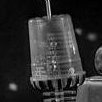I had a quiet afternoon so I wrote a pattern file for a Wood Flooring Hatch. It is based on a plank width of 150 drawing units, and lengths to suit your picture. One cannot have a completely random hatch pattern, but if the repeat spacing is large enough, the eye can get fooled.
Here is the pattern file, and you will notice that at the end, instead of a blank line, one can put a line starting with a * and then one can put a credit for the creator. Save the file as WoodFloor.pat and put it where AutoCAD can find it.
*WoodFloor, Wooden Flooring
0,0,0,0,150
90,125,0,0,3015,150,-300,150,-450
90,0,150,0,3015,150,-600,150,-150
90,280,750,0,3015,150,-900
90,470,300,0,3015,150,-900
90,565,600,0,3015,150,-900
90,752.5,900,0,3015,150,-900
90,941,150,0,3015,150,-900
90,1350,450,0,3015,150,-900
90,1412.5,750,0,3015,150,-900
90,1485,0,0,3015,150,-900
90,1697.5,300,0,3015,150,-900
90,1791,600,0,3015,150,-900
90,2074,900,0,3015,150,-900
90,2168,150,0,3015,150,-900
90,2546,750,0,3015,150,-900
90,2671,0,0,3015,150,-300,150,-450
90,2892,300,0,3015,150,-150,150,-600
*eldon, CADTutor Forum 2020

